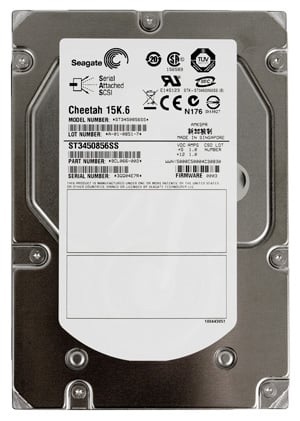Seagate Cheetah 15K.6 Hard Drive
Drive Details
Visually, Seagate’s Cheetah 15K.6 drives are not that striking. There aren’t any major design changes in terms of the drive design compared to prior generation Cheetah 15K.5 drives. The aspect which we can’t convey visually is that these drives definitely feel enterprise class – in that they are much heavier than a traditional desktop hard drive. As high-end SCSI drives such as this are designed for usage in enterprise-class workstations and servers, they have far greater reliability ratings and have greater thermal tolerances too. This particular model is Seagate’s high-end model, in terms of speed and capacity, with a massive 450 GB of storage space. For a 15K drive, this is monstrous – and roughly three times the capacity of most manufacturers' solid state drives (most peak at 128GB, currently).

Seagate Cheetah 15K.6 - Top |
 Seagate Cheetah 15K.6 - Bottom |
So, what IS this thing? Let’s break down the specifics. The Cheetah 15K.6 is a 15,000 RPM hard disk which runs on a Serial Attached SCSI 3 GB/s (SAS) connection. Fibre channel is an option as well, but Serial ATA is not, which means that if you want to run one of these new disks, you’ll need a SAS controller card. SAS controller cards can be had for under $100 on the low-end, but if you want a true hardware RAID controller, you should be prepared to shell out at least $300 for a four-port card.
The Cheetah 15K.6 sports capacities up to 450 GB at the high-end, but also comes in 300 GB and 150 GB flavors. As the 15K.6 is a quad-platter drive (with eight read heads), this means that each of the 15K.6’s platters is sporting a capacity of at least 113 GB, although full capacity of the platters is unknown. The Cheetah 15K.6 is utilizing Seagate’s second generation perpendicular recording technology, the first generation being the X15.5.
Seagate’s specifications show idle acoustic levels of 36 dBA and power consumption levels of 17W when writing, which are indeed high on both counts. For comparison, most traditional desktop hard drives run at about 26 dBA with power consumption levels of 7-10W – but as we’ve said before, this is no traditional hard drive. Seagate claims that this drive has the best numbers in terms of IO’s per second (per watt), a statistic we haven’t seen before, but one which is certainly valid in this day and age of power consumption. How they can claim this in comparison to SSD’s, which can deliver tremendous IO’s at incredibly low wattage is somewhat unbelievable, but compared to traditional SATA hard disks, Seagate might have a point.
Amazingly, for a drive of this speed, Seagate only equips the Cheetah 15K.6 with 16 MB of cache memory. This seems to be standard for Seagate’s enterprise class drives, as they have maintained solid performance all along with this healthy (but in this day and age, not that impressive) 16 MB of cache. While many high-end desktop drives are being equipped with larger 32 MB cache buffers, one thing to keep in mind is that for enterprise class SAS hard drives, you’ll likely be using them with a RAID card with its own cache memory. For example, the Adaptec SAS card we used is equipped with a huge 128 MB of cache by default – so having 16MB of cache is not a huge turn-off for us. Obviously, it’s not hurting their performance numbers – and for a drive of this caliber, if adding extra cache would have greatly helped performance, they would have put it on. Cache is (relatively) cheap – so the 16MB cache buffer size was likely sized for this drive purposefully.
The 15,000 RPM spindle speed not only helps with sustained throughput, it also helps with seek times. While not as impressive as the ~0.1 ms seek times of solid state hard drives, the Cheetah 15K.6’s 3.4ms average seek time is unbeatable when it comes to platter-based storage. Average latency is an impressively low 2.0ms. In plain English, this means that when you want your data, it’s going to be able to find it damn near instantly.
Seagate backs this drive up with a standard five year warranty, and tags this drive with a massive 1.6 million hour MTBF (mean time between failure) rating. Typically, most enterprise level hard drives (and most SSD’s) have 1 million hour MTBF ratings, so this shows that Seagate is going above and beyond with these drives. Thanks to Google calculator, we can share with you the following statistic. 1.6 million hours = 182.527284 years. Looks like your data will be safe for a while. For those weary of other eyes seeing your data, Seagate also offers a self-encrypting drive option, however this is only available to OEMs at this point.






